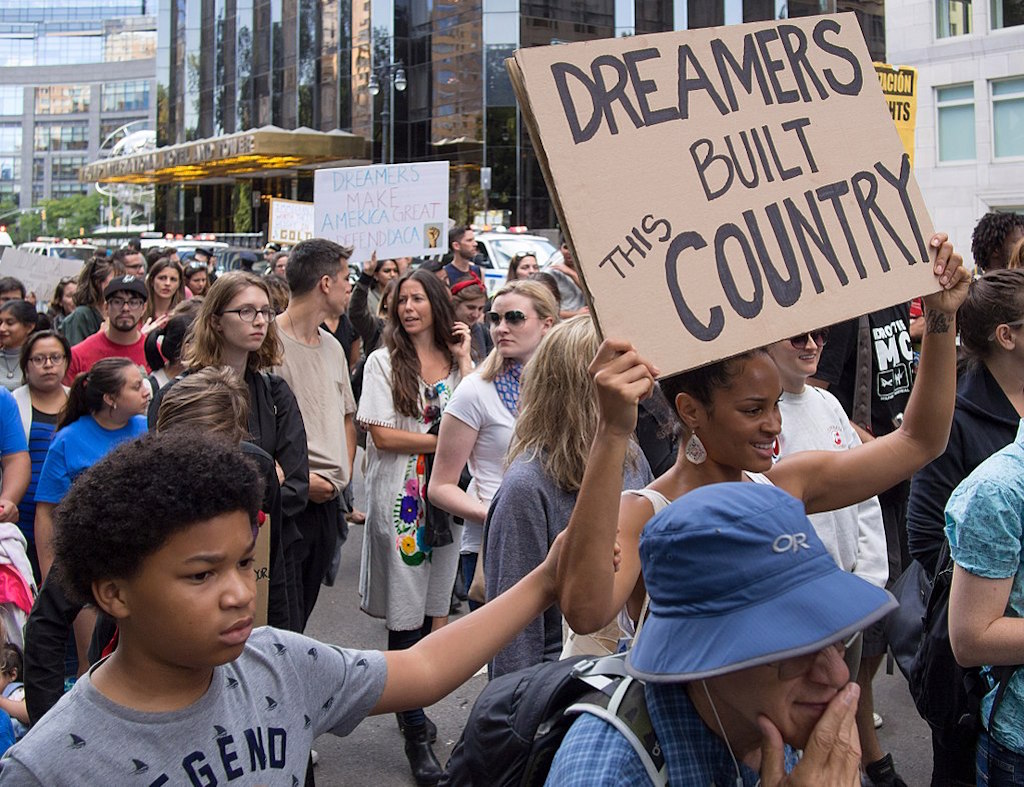Who Will Protect the Dreamers?
Until Congress or the courts take lasting action, DACA recipients remain in legal limbo. Deferred Action for Childhood Arrivals supporters at a 2017 rally in New York City. (Rhododendrites / Wikimedia)
Deferred Action for Childhood Arrivals supporters at a 2017 rally in New York City. (Rhododendrites / Wikimedia)
As members of Congress worked against the March 5 deadline Donald Trump had imposed to end the Deferred Action for Childhood Arrivals (DACA), two federal district courts ruled that DACA would continue — for now. On March 6, a third district court judge found Trump’s termination of DACA to be lawful. The conflict among the courts of appeals increases the likelihood that the Supreme Court will review the case. It remains to be seen whether Congress or the courts will ultimately take action to protect the Dreamers.
“Anguish and Anxiety” for Dreamers
When she was three years old, Maria, a now 32-year-old Dreamer, came to the United States from Mexico. She eventually put herself through San Diego State University and is now working her way through graduate school. She helped raise her developmentally disabled, sight-impaired US citizen sister while their mother, who has a green card, worked seven days a week.
Maria told Truthout that being sent back to Mexico is “unimaginable;” it would be “heartbreaking” to be forced to leave her family. “All the work, all the efforts, all the time and dedication I’ve put in would go to waste,” she said. Maria, who hopes to become a marriage and family counselor, is working full time at a children’s mental health program as she pursues her graduate studies. “I work providing hope to others,” she said. “My whole life is here. The uncertainty causes anguish and anxiety.”
Other Dreamers are anxious as well. “If there’s no permanent solution, I lose everything,” Eden N’Guessan stated at an event organized by the Staten Island Immigrants’ Council in New York. “I have to drop out [of school] and basically can’t work. I want to do social work and help the homeless, that’s my passion,” added N’Guessan, who arrived in the United States from West Africa at the age of eight, and whose comments were reported by the Staten Island Media Group.
“If I lose [DACA], I go back into the shadows again. I could [not] face going back to my native country, where it’s not home to me. [US] is home; this is where I was raised, this is my country,” said Jose Mejia, who was brought to the US when he was two years old. “If it expires, I lose everything. I lose my health care, my job, my schooling, and I’m not protected if I get deported,” he stated at the council meeting. “I pay taxes and work as a nursing assistant at Eggers; I take care of American senior citizens, I contribute just as much as any other American.”
The Obama administration established DACA in 2012 to grant people brought to the US before age 16 a reprieve from deportation if they continuously lived here, were enrolled in school and didn’t pose a threat to national security. DACA applicants were assured that the personal information they submitted would not be used to deport them.
Nearly 1 million undocumented immigrants came out of the shadows and applied for DACA. Successful applicants received work authorizations in renewable two-year increments. As of September 2017, approximately 700,000 people were actively enrolled in DACA.
On September 5, 2017, Attorney General Jeff Sessions announced that DACA would expire on March 5, 2018. Sessions claimed that Obama had violated the Constitution when he created DACA.
Constrained by Trump’s Demands, Congress Comes Up Short
Trump has vacillated on DACA — ordering a March 5 termination of the program, issuing statements supporting the Dreamers, appealing federal court decisions that keep DACA temporarily in place, and erecting insurmountable obstacles to a congressional solution.
After Sessions’s September 5 announcement, Trump tweeted, “Congress now has 6 months to legalize DACA (something the Obama administration was unable to do). If they can’t, I will revisit this issue!” Promising a presidential revisiting of DACA flies in the face of his administration’s position that Obama had illegally bypassed Congress by establishing DACA. Two days later, in another tweet, Trump wrote, “For all those (DACA) that are concerned about your status during the six month period, you have nothing to worry about — No action!”
Trump called the Dreamers “absolutely incredible kids” and “good, educated and accomplished young people.” He pledged, “We’re going to deal with DACA with heart … because, you know, I love these kids.” He later told reporters, “We love the Dreamers. We think the Dreamers are terrific.” Trump said he wanted “a bill of love.”
Yet when Congress members tried to hammer out a compromise bill to shield the Dreamers, Trump showed no love, opposing a standalone bill that would protect them. He indicated he would not sign any legislation that did not include $25 billion for his border wall, and an end to family migration and the diversity visa lottery program. When legislators could not agree on his terms, Trump accused Democrats of “doing nothing” to protect the Dreamers.
Trump is holding the Dreamers hostage to his rabid anti-immigrant base.
Two Federal Judges Temporarily Continue DACA
Meanwhile, two federal district court judges disagreed with Sessions and granted nationwide injunctions against the March 5 termination of DACA. Judge William Alsup in San Francisco ruled on January 9, 2018, and Judge Nicholas G. Garaufis in New York ruled on February 13, 2018, that the plaintiffs challenging the termination of DACA were likely to prevail on the legal merits and would likely suffer irreparable harm if DACA were allowed to expire on March 5. The plaintiffs include individuals and several States as well. DACA recipients would lose their work authorizations and employer-sponsored health care coverage, and State plaintiffs would lose $215 billion in GDP over the next decade.
Both judges concluded the Trump administration’s decision to end DACA was “arbitrary and capricious.”
In his 55-page opinion, Judge Garaufis wrote the administration “acted arbitrarily and capriciously by ending that program without taking any account of reliance interests that program has engendered.” He cited DACA recipients who “raised families, invested in their education, purchased homes and cars, and started careers” and employers who hired, trained and invested time in DACA-recipient employees. “Former DACA recipients will be separated from their families and communities,” Judge Garaufis noted. “It is impossible to understand the full consequences of a decision of this magnitude.”
Judge Alsup likewise argued in his 49-page opinion that the termination of DACA “would tear authorized workers from our nation’s economy and would prejudice their being able to support themselves and their families, not to mention paying taxes to support our nation.” Moreover, “authorized workers will lose the benefit of their employer-provided healthcare plans and thus place a greater burden on emergency healthcare services,” he added.
“DACA is not unconstitutional simply because it was implemented by unilateral, executive action without express congressional authorization,” Judge Garaufis stated. “The Executive Branch has wide discretion not to initiate or pursue specific [immigration] enforcement actions.” His examples of “deferred action” included victims of trafficking and violence against women, foreign students affected by Hurricane Katrina, and some widows and widowers of US citizens.
In a footnote, Judge Garaufis said, “It is not clear how the President would ‘revisit’ the decision to rescind the DACA program if the DACA program were, as the Attorney General has stated, ‘an unconstitutional exercise of authority of the Executive Branch.'”
Both judges ruled that the administration must continue to accept renewal applications from current DACA enrollees but need not accept new applications.
But on March 6, 2018, Maryland federal district judge Roger W. Titus held that the Trump administration did not act arbitrarily and capriciously in ending DACA because its rationale was “based on recent court decisions and the advice of the Attorney General, that DACA was unlawful.” Judge Titus added, “Assuming that a reasonable basis for that belief exists in the Administrative Record, how could trying to avoid unlawful action possibly be arbitrary and capricious? Quite simply, it cannot.”
Judge Titus stated, however, “This Court does not like the outcome of the case, but is constrained by its constitutionally limited role to the result that it has reached. Hopefully, the Congress and the President will finally get the job done.”
The Courts’ Next Steps for DACA
In the ordinary course, these district court rulings would be appealed and reviewed by the circuit courts of appeals. The Supreme Court would then take up the cases after the appellate courts had ruled on them.
However, Trump asked the Supreme Court to bypass the circuit courts and conduct an expedited appeal of the district court injunctions. The high court circumvents intermediate appellate review only when a case is of “such imperative public importance as to justify deviation from normal appellate practice.” This unusual procedure occurred when the nation’s steel production was threatened by a 1952 strike, and when Richard Nixon refused to relinquish White House tapes in 1974.
The Dreamers’ case does not satisfy that standard of urgency. Thus, the Supreme Court, without dissent, declined to review Trump’s appeals of the injunctions until after the circuit courts have issued their decisions. The high court stated that it expects the appeals courts to proceed expeditiously. A final determination could take a year and will probably not come before 2019.
Meanwhile, a September Washington Post/ABC News poll found that 86 percent of those polled support allowing the Dreamers to remain in the United States.
But until Congress or the courts take lasting action to protect them, the Dreamers remain in legal limbo.
Copyright, Truthout.org. Reprinted with permission.
Your support matters…Independent journalism is under threat and overshadowed by heavily funded mainstream media.
You can help level the playing field. Become a member.
Your tax-deductible contribution keeps us digging beneath the headlines to give you thought-provoking, investigative reporting and analysis that unearths what's really happening- without compromise.
Give today to support our courageous, independent journalists.






You need to be a supporter to comment.
There are currently no responses to this article.
Be the first to respond.